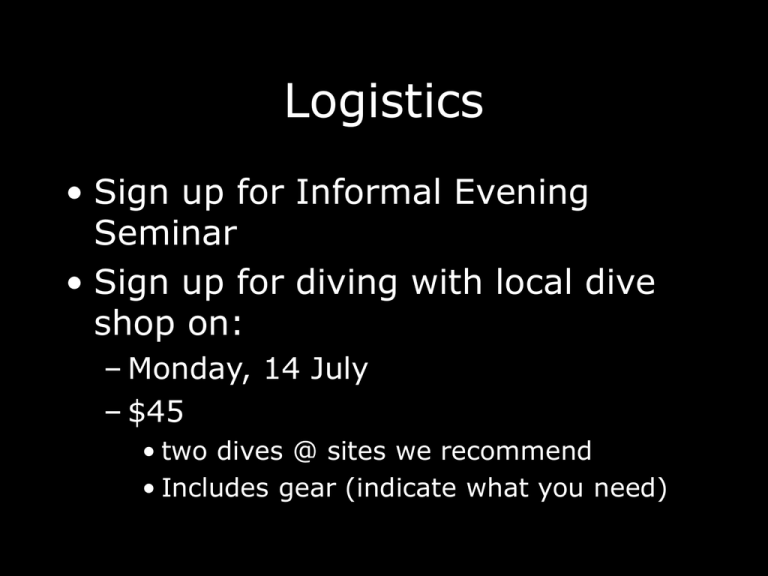2_Collections_Management_Wysor.ppt
advertisement

Logistics • Sign up for Informal Evening Seminar • Sign up for diving with local dive shop on: – Monday, 14 July – $45 • two dives @ sites we recommend • Includes gear (indicate what you need) Collections Management So many algae, so little time. 2 Collections Management • Permits are required to collect marine organisms in Panama – STRI is covered by a marine collecting permit – Exporting dead/live specimens requires separate permits. • Requirement of permitting is to provide duplicate specimen for deposition at University of Panama – Co-ordinate sample export with course instructor if necessary • Don’t over-collect, you’ll only waste time throwing out rotten, smelly seaweed • Collect sufficient material to preserve appropriately 3 Collections Management • Goal – To be able to recall collection information associated with each sample at a later date (months, years, decades from now) – (14 collection days) x (16 collectors) x (10 specimens) = 2240 specimens! • Record unique identification number for each specimen using class spreadsheet – iMac: TFP Workshop Folder: TFP_08_Specimens.xls 4 Collections Management: Identification • Identification may require multiple strategies – Morphological examination of fresh material is best • Photomicrography is available in lab • Image data will be transferred to iMac from 17:00-17:30 everyday by Jessie & Liz – Folders: S1, C1 (door bench) S2, C2 (window bench) – Preservation is always required for vouchering • Herbarium • Formalin – 4-5% Formaldehyde solution in seawater from collection site 5 Collections Management: Preservation • Herbarium preparation corrugated cardboard felt blotter newsprint specimen newsprint felt blotter corrugated cardboard Data recorded in spreadsheet must be recorded on herbarium sheet. 6 Collections Management: TFP Goals 1. Contribute accurately identified specimens to BRS Reference Collection (and UP) 2. Contribute species records to BdT Biodiversity Database http://biogeodb.stri.si.edu/bocas_database/search/kingdom/2/ 3. Document the morphology of select species as part of a series of photographic plates Addressing these goals will promote your understanding of tropical algal diversity 7 Collections Management: Identification • Identification may require multiple strategies – Molecular Work (DNA Sequencing/Barcoding) • Extraction of fresh material is best • Integrity of DNA is preserved by rapid drying – Non-formalin fixed herbarium specimens can be used – Silica gel promotes rapid drying 8 Collections Management: TFP Goals • Contribute specimens and morphological observations to class DNA Barcoding Project • Hypotheses: – H0: Species richness of taxon x as determined by morphological examination is the same as determined by molecular examination (sequencing of coxI mitochondrion gene) – Ha1: DNA barcoding of taxon x reveals cryptic (hidden) diversity • Morphologically identical specimens are genetically distinct – Ha2: Morphological variability within taxon x conceals genetic similarity • Morphologically variable specimens are genetically identical 9 Collections Management: TFP Goals • Means of tracking information is absolutely essential to reconcile – Specimen records with field/lab image data – Specimen records (i.e., morphology, ecological/geographic distribution) with molecular data • Ensure that your specimen records are updated daily in the Excel spreadsheet – Do not put specimens in press without logging or labeling – There may be bottle-necking at spreadsheet • Claim number by entering collection information even if identity is uncertain, update later • Use safe copy & pasting to facilitate data entry 10 Laboratory Maintenance • Microscopes – Always clean up seawater spills on microscopes immediately – Wipe down slide platform (compound scope) or glass base (stereo scope) daily – Replace dust cover – Conserve slides/cover slips as best as possible • Slide drying on your own table, not in common space next to sink • Broken/used slides/cover slips in glass waste • Lab tables – Keep workspace clean – Return literature to literature table when not in use • Use fans overnight to facilitate herbarium drying 11 Laboratory Maintenance • Sea Water Tables – Keep your specimens in labeled containers/bags • May be hard to keep track of free-floating specimens – Change water in baggies at least daily – Don’t hold specimens for more than 1-2 days, maximum – Get rid of old specimens (not in trash) • Waste bucket will be established in lab, ensure it is emptied at least once/day • Spills – Clean them up – Try to avoid electrical outlets 12 Collections Management: Field Photography • 3 cameras are available for in situ photography – Canon PowerShot 720 – Canon underwater housing (WPDC16) rated to 130’ • Cameras will be prepared for field use by Jessie & Liz • Return cameras to Jessie & Liz in the field • Image data will be downloaded by Jessie & Liz QuickTime™ and a TIFF (Uncompressed) decompressor are needed to see this picture. QuickTime™ and a TIFF (Uncompressed) decompressor are needed to see this picture. 13 Collections Management: Field Photography • Work in pairs to photo-document selected specimens – Photograph # on numbered collection bag (to segregate image data by specimen) – Photograph specimen (multiple images) – Place photographed specimen into numbered bag – 1 specimen/bag – Ultimately, you will need to generate image file name and link it to specimen number in MS Excel spreadsheet QuickTime™ and a TIFF (Uncompressed) decompressor are needed to see this picture. QuickTime™ and a TIFF (Uncompressed) decompressor are needed to see this picture. 14





